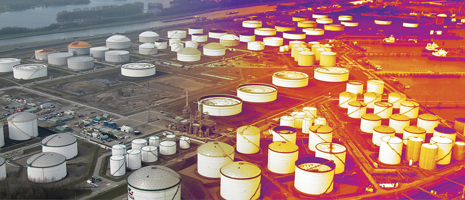Innovative thinkers
Genscape: The new ‘real time’: Helicopters, infrared and visual spectrum technology
|
Genscape
In a world where time is money, being able to deliver real-time data to the marketplace is crucial. This is especially true in the oil patch, where monitoring crude oil inventory, as well as production rates, can help ensure accurate market valuation and detect signs of trouble when production levels decrease—even by the smallest amounts. One company, U.S.-based GenScape, has combined a unique set of technologies to establish a whole new standard for what the term “real time” means. Over a decade ago, a dedicated team in Genscape’s energy division decided to look at real-time monitoring in a new way, literally from the ground up and the sky down. Their first focus was on the electricity market, in using remote sensing to find a way to use electromagnetic frequency (EMF) monitoring on power flows along lines. “We saw that it worked in the power market, so we thought, could it work somewhere else?,” said Senior V.P. Abudi Zein. In its ground-up approach, beginning with the terminal at Cushing, Oklahoma, Genscape determined that the best way to ascertain tank storage levels was from a bird’s eye view aimed directly at the source, and through EM techniques. The company has a fleet of helicopters that it uses to fly over the tanks twice each week, and by using visual spectrum photography, measures the elevation of the floating tanks’ roofs. The flyovers also use infrared visualization, which verifies storage levels in fixed-roof tanks by measuring heat levels that are detected from invisible vapor above the tank’s liquids. Genscape analyzes the data, which are released every week. Genscape has recently developed a way to monitor crude flow from beneath the North Sea. Real-time data are especially important when it comes to complex production systems—in delivering production rates from various terminals and in being able to detect production decreases. “The same technology that we use for Cushing storage and pipelines, we applied to the Forties system,” said Managing Director of Oil Chris Sternberg. The company is also monitoring the fractionation plant at Kinneil, and the refinery at Grangemouth. In addition, Genscape measures tank levels at Dalmeny and tracks ship loadings at Hound Point. Between the offshore Unity oil gathering platform and the Kinneil processing facility, there are four pumping stations, which are activated when the flow reaches 400,000 bpd. Genscape monitors the power flows on the powerlines that supply electricity to the oil pumping stations by using proprietary technology. The power monitors are placed near the power lines and measure electromagnetic fields (EMF) generated by the lines. Through analyzing the electromagnetic field data with a system of algorithms, the EMF data are converted into oil flowrate data. In monitoring the onshore power flow from multiple pumping stations every 30 minutes, along with the separation process onshore and refining operations, Genscape can detect even the smallest changes in crude levels from the offshore fields. This ability to report offshore production outages is critical for oil traders. Once onshore, NGLs are separated from the crude at the Cruden Bay terminal. Genscape has a fixed camera that monitors the operations of the three fractionation trains. The crude is then sent to either storage, onto ships at Hound Point or to the Grangemouth facility, where Genscape uses infrared cameras to monitor hot gas emissions to detect upsets, ramp-ups and shut-downs. Whether from the sky or with sensors deep beneath the rough North Sea waters, Genscape continues to push the envelope on what real-time monitoring means. “We can now monitor the system throughout the whole Forties supply chain,” said Zein. “We are doing things that have never been done, and applying a set of technologies to more and more challenging environments.”
|
- What's new in production (February 2024)
- Prices and governmental policies combine to stymie Canadian upstream growth (February 2024)
- U.S. operators reduce activity as crude prices plunge (February 2024)
- U.S. producing gas wells increase despite low prices (February 2024)
- U.S. drilling: More of the same expected (February 2024)
- U.S. oil and natural gas production hits record highs (February 2024)
- Applying ultra-deep LWD resistivity technology successfully in a SAGD operation (May 2019)
- Adoption of wireless intelligent completions advances (May 2019)
- Majors double down as takeaway crunch eases (April 2019)
- What’s new in well logging and formation evaluation (April 2019)
- Qualification of a 20,000-psi subsea BOP: A collaborative approach (February 2019)
- ConocoPhillips’ Greg Leveille sees rapid trajectory of technical advancement continuing (February 2019)



